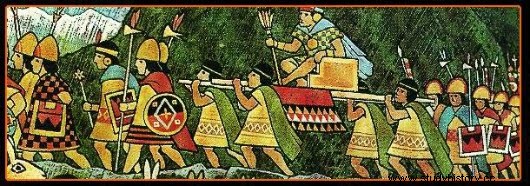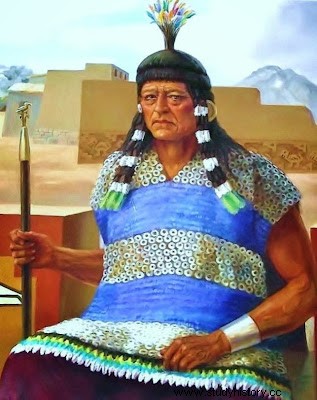The traditional curacas had functions:
“rituals and ceremonies, which had to do with the worship of ancestors, the main source of power and legitimacy of the curaca”[ 1];This “specialist of the sacred” mediates between men and supernatural beings that guard the cosmic order, while organizing offerings or common festivals. The curacas had several women, known as aqllas, chosen castes by lineage and beauty, benefiting from the creation of new kinship relationships.

The name of it is a much discussed issue, some chroniclers claim that
“the curaca was not a hereditary chief, but a man who came to office through a ritual selection process, and who, consequently, could be stripped of it through similar procedures”[2].However, this thesis has little support compared to the one defended by important researchers such as Jonh V. Murra, assuring that the position is hereditary, not always in a patrilineal sense, but in the family:
“that when the main cacique died, if he had a grown son who could command, he did not dare to exercise his authority [...] that he give him license and seat of his cacicazgo and so the ynga gave it to him ”[3].The majority had a clear ethnic origin and were nominated through rituals in each ethnic unit, from which the position was relayed, since it is increasingly debatable that the curacas were appointed by the Tawantinsuyu, and in specific cases by the Inka. .The most important function of the curaca was to organize reciprocal relations, which implied obligations within the ayllu, exchange relations; their relationship with the population is made by accepting reciprocity.
“These exchanges, which allowed the same population to have simultaneous access to resources very distant from each other, they have been described as “trade” by researchers who use models from other latitudes [...] with limited relationships of ritual barter or seasonal exchanges”[4].The society lacks trade, but despite this it is rich, expansive and organized, through exchanges or bartering, identified by some historians as "trading in the manner of Indians" [5], whose existence is undeniable, both by linguistic signs and archaeological remains of pre-Hispanic ceramics, etc. The market was nonexistent, so the deposits could be the main economic value of the community;
“in contrast to the region Andean region, politically integrated by the centralized power of the Incas, Mesoamerica was always politically divided. But what politics did not do was done by trade […] a complex system of exchanges from simple bartering within the village to the large specialized markets of the cities, culminating in international traffic.”[6]The Andean fairs would emerge during the 16th century, adding European patterns of exchange, occupying the space of previous rituals and traditions and spreading commercial criteria. Reciprocity is identified as equitable, when a man receives the work of another by reciprocity, he must be "generous" to feed, house and clothe him; the curaca had to fulfill the obligations of those who rendered him "service", although he gave the appearance of "superior rank". However, over time, the mita will be an obligation to power, much more rigorous in the colonial period than in the pre-Hispanic period.

The relationship included exchanges of presents between different groups, ceremonial exchange that established relationships between neighboring groups , both as presents or as goods with a ritual character, coca leaf for example, but without a market as such; We can therefore affirm that the Tawantinsuyu is an organization based on reciprocity and the redistribution of goods.
The benefits received by the power are not considered a tribute as such, since we are not dealing with a “tyrant” lord who exploits the population, it is thought that it was produced in kind due to the absence of currency and that part of that “tax income” was distributed among the population, in a more redistributive way than a “charitable” distribution.
The existence of the Andean mita was based on the delivery of labor to power so that it could organize the production of redistributable goods, according to the population. This mobilization of people was used for planting, harvesting, ore collection, etc. Author:Héctor Martínez Alonso for revistadehistoria.es
Bibliography:
[1] RAMIREZ, Susan E. (2001). “Curacas and cosmology: the ancestral power in the Andes” in GARRIDO ARANDA, Antonio (coord.) “About Raúl Porras Barrenechea:old and new themes of Andean culture” University Publications Secretariat. Cordoba, p. 157
[2] MARTÍNEZ, José Luis (1982). “An approach to the Andean concept of authority, applied to ethnic leaders during the 16th and early 17th centuries” . Pontifical Catholic University of Peru, Lima.
[3] ORTIZ DE ZUÑIGA, Iñigo. (1967)“Visit to the province of León de Huánuco in 1562”, ed. by John V. Murra, Lima.
[4] MURRA, John V.(1999). “The Tawantinsuyu” in General History of Latin America. Vol. I:The original societies. Madrid-Paris, UNESCO-Trotta, p. 489
[5] ROSTWOROWSKI DE DIEZ CANSECO, María:(1977). “Ethnicity and society. Pre-Hispanic Peruvian coast” Institute of Peruvian Studies, Lima, p. 133
[6] SEMO, Enrique.(2006).“Economic history of Mexico”. Vol. I:The origins. From Hunters and Gatherers to Tributary Societies, 22,000 BC to 1519 AD. Mexico, National Autonomous University of Mexico-Océano, 2006, p. 149
